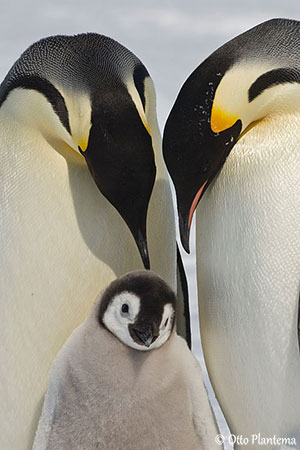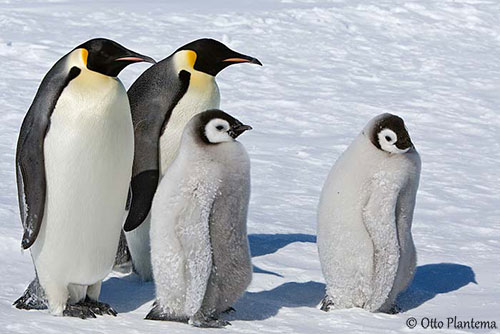
Fr: Manchot empereur
All : Kaiserpinguin
Esp : Pingüino Emperador
Ital: Pinguino imperatore
Nd: Keizerspinguïn
Sd: Kejsarpingvin
Photographer:
Otto Plantema
Trips around the world
Text by Nicole Bouglouan
Sources:
HANDBOOK OF THE BIRDS OF THE WORLD vol 1 by Josep del Hoyo-Andrew Elliot-Jordi Sargatal - Lynx Edicions - ISBN: 8487334105
BirdLife International (BirdLife International)
Animal Diversity Web (University of Michigan Museum of Zoology)
PhotoVolcanica - Photography and Information by Dr Richard Roscoe
PENGUINWORLD (Lloyd Spencer Davis)
Les Manchots (François Durand)
Wikipedia, the free encyclopaedia
Emperor Penguin
Aptenodytes forsteri
Sphenisciforme Order – Spheniscidae Family
INTRODUCTION:
The Emperor Penguin is the largest species of this family. It lives in very harsh environment on the Antarctic ice, and forages in the surrounding cold waters. This inhospitable habitat involves first physical adaptations, and then co-operative behaviours, in order to survive, feed and breed in such extreme conditions.
This amazing bird has beautiful appearance as well as chick as adult. They spend all the year between Antarctic ice and nearby waters. They are living on frozen sea-ice where they breed in colonies.
DESCRIPTION OF THE BIRD:
Biometrics:
Length: 112-115 cm
Weight: M: 35-45 kg – F: 28-32 kg
The adult has blue-grey upperparts and flippers, and black head and tail.
The underparts are white, bordered by black band along the dark upperparts.
On the head, there are deep yellow-orange ear patches on each side of the head, fading and turning pale yellow to white down neck and upper breast. Head, chin and throat are black.
The bill shows black upper mandible and pink to orange lower mandible. The eyes are black. Legs and webbed feet are black with sharp black claws.
Both sexes are similar, with male slightly larger than female.
The immature resembles adults but ear-patches, chin and throat are white.
The chick has silvery-grey down. The head is black with white eye area and cheeks.

This species is especially adapted to harsh weather conditions. It has small feet, head and bill compared to the body size. Flippers are proportionally smaller than in other penguins’ species. Thanks to a highly developed circulatory system, the heat is retained within the body. In addition, there are multiple layers of tightly-packed scale-like feathers, and the strong claws allow the penguin to grip the ice in strong winds.
RANGE:
The Emperor Penguin is circumpolar and restricted to Antarctica. The breeding colonies occur on the ice around the Antarctic continent, the Antarctic Peninsula and the adjacent islands.
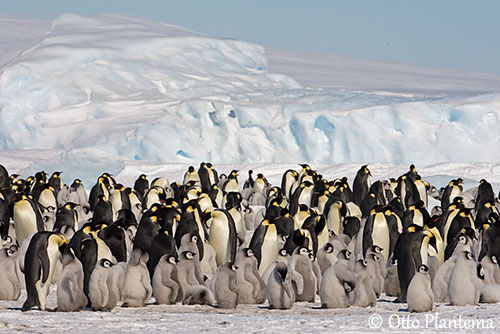
HABITAT:
The Emperor Penguin is marine and pelagic outside nesting period. The breeding colonies are found on stable pack ice, usually near the coast, but sometimes up to 18 km offshore. However, there are two small colonies on land.
Colonies are usually sheltered by ice cliffs and icebergs which protect them from the strong winds.
The Emperor Penguin is an offshore feeder and forages in the cold Antarctic waters.
CALLS ANS SONGS: SOUNDS BY XENO-CANTO
The Emperor Penguin has complex vocalization system, used for mutual recognition between mates, and between parents and chicks. This is a “two-voice” system, with sexual dimorphism in voice. The contact call can be heard a kilometre away and is used while foraging and travelling.
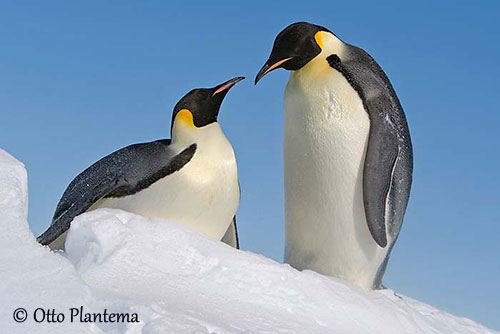
BEHAVIOUR IN THE WILD:
The Emperor Penguin feeds on fish, cephalopods, krill and crustaceans. It may feed both in open water and under the sea-ice where it can find large amount of small fish.
The adult catches its preys by pursuit-diving. It forages usually at depth of less than 50 metres, but it has been recorded between 265 and 500 metres depth. It may dive during about 15 minutes. It usually moves at speed of about 10km/hour, but over short distance, it can reach up to 20 km/hour. They may travel 150 to 1000 kilometres in a single foraging trip.
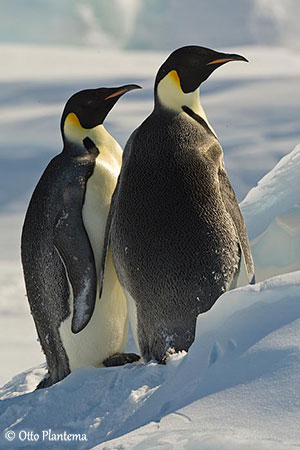
Several Emperor Penguins may sometimes hunt together and co-operatively. But single trips can last several weeks, with penguins up to 500 kilometres from their colonies.
They are gregarious and breed in large colonies. They are not territorial, because they need great numbers of birds to survive. They breed during the austral winter with low temperatures, strong winds and darkness.
As they are living is harsh weather conditions, Emperor Penguins have developed peculiar behaviour. During the winter months, the males remaining at colonies while females are foraging, form a tightly-packed “turtle-formation”. The birds lean on each other and step by step, shift positions in order to benefit from the protected warmer area in the centre of the turtle formation.
In March/April, the Emperor Penguin reaches the breeding grounds by walking across the sea-ice, sometimes as far as 120 km. They walk in a single line over the ice pack.
The male initiates the courtship with the ecstatic display. The head is held skywards and the flippers are spread while the male calls during a few seconds. This display is repeated as it walks around the colony. Then, the female joins it, and both stand facing each other while stretching the head skywards in synchrony for a few minutes. Both mates may also waddle around the colony before to perform deep bowing prior to copulation.
The Emperor Penguins may have long-term pair-bonds, but only 15% breed with the same partner over several years.
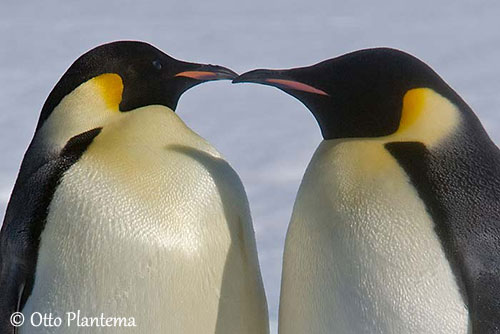
This species is dispersive into oceans between January and March, during which they travel and forage in groups. They are vagrant to New Zealand, S parts of South America and several sub Antarctic islands.
They are good swimmers with speeds of 3, 40 metres/second. On land, they walk and waddle, but also perform tobogganing, propelling themselves along the ice, pushing with their feet and sliding on their bellies.
The moult occurs in January/February, and occurs over shorter time than in other species, taking around 34 days.

REPRODUCTION OF THIS SPECIES:
They arrive at colony in March/April, when the sunlight is decreasing. The laying occurs in May/June. The Emperor Penguin is colonial but not territorial. They do not build nest.
The female lays a single egg which is transferred to the male, while the female goes out to sea for feeding during two months. The male incubates the egg during 35 days, by holding it on its feet against the brood patch. The incubating males huddle together to avoid cold and wind. The male loses half of its body weight during the incubation period.
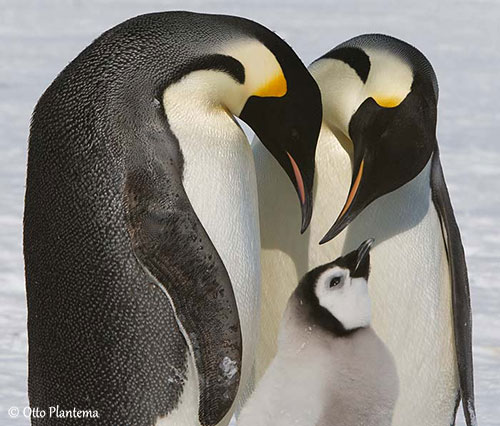
The female returns in mid-July/early August, at time for hatching, and feeds the chick with regurgitated fish. If the return is delayed, the male can feed the chick with a kind of milk from its oesophagus. Once the female has returned, the male goes out at sea for feeding during 25 days.
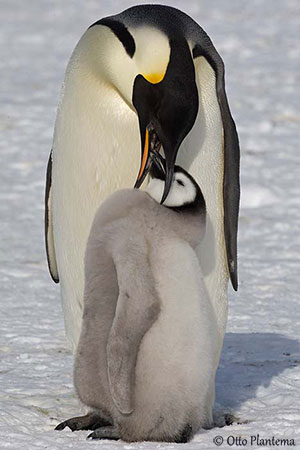
The chick remains on parent’s feet during the first 45-50 days. After this period, it joins a crèche with other chicks and it is still fed by both parents. It moults in November/December, and gains the juvenile plumage. It can go out to sea for feeding in December/January. It reaches the sexual maturity at 3 years old, but it usually breeds 1-3 years later.
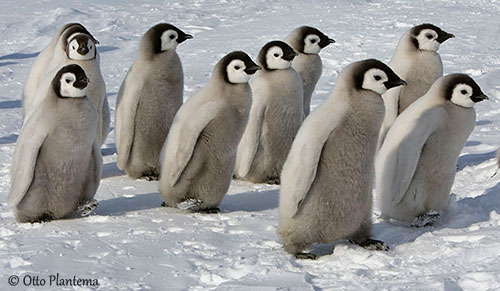
PROTECTION / THREATS / STATUS:
The Emperor Penguin will be threatened in the future by climate change involving decrease in sea-ice concentration and thickness, and also by climatic weather variations. Human disturbances in some areas, with the proximity of scientific bases and aircrafts’ movements, are an important threat for colonies.
There are 46 colonies with 238 000 breeding pairs (2012).
The chicks on land are preyed upon by Giant Petrels. The adults are attacked at sea by Leopard sea-lions, but immature and weak penguins are the most usual preys.
Currently, the Emperor Penguin is listed as Near Threatened.
